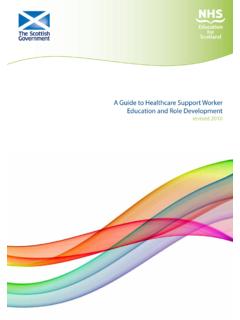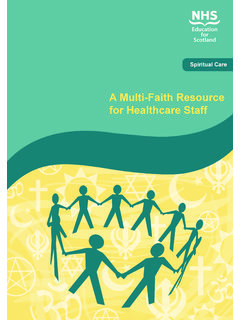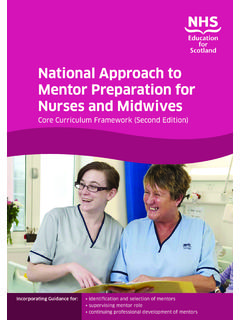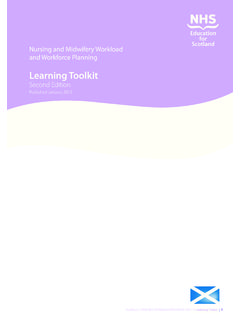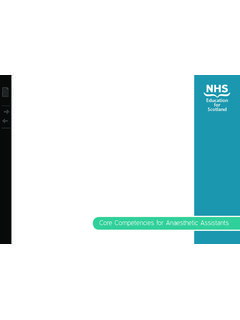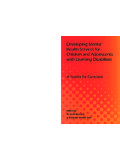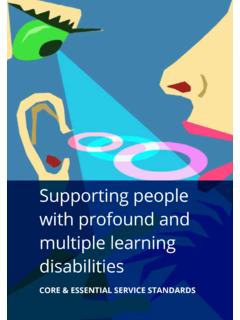Transcription of Postural care – protection of body shape - NES
1 Learning Byte Postural care . protection of body shape Tess Ellis, Simple Stuff Works 1. NHS Education for Scotland 2016. You can copy or reproduce the information in this document for use within NHSS cotland and for non-commercial educational purposes. Use of this document for commercial purposes is permitted only with the written permission of NES. 2. Learning Byte | Postural care Contents Welcome to this Learning Byte! .. 4. What has Postural care got to do with me? .. 5. 24-hour Postural care .. 16. Risk of body shape changes in different populations .. 27. What are the consequences of failing to provide Postural care ? .. 31. How do we know if therapeutic positioning is working?
2 35. Summary and conclusion .. 37. References and further reading .. 38. 3. Welcome to this Learning Byte! This learning byte has drawn on: stories from people who have altered body shape due to lack of Postural care stories from people who have been supported successfully to protect and improve their body shape the experience and knowledge of families, paid carers, therapists and equipment suppliers who support people needing Postural care . What is a Learning Byte? It's an alternative to a traditional, structured, beginning-to-end course that is available in bite-sized chunks in the workplace. You can access it in different ways on a PC or a mobile device, for instance and at any time.
3 Who is it for? We've developed this Learning Byte for students from all four fields of nursing adult, mental health, learning disability and children's. It will also be relevant for other clinicians (such as therapists) and paid carers working with people who need Postural care as well as family carers and self-advocates. What will I get from this Learning Byte? The Learning Byte provides you with a brief guide to Postural care . By the time you have completed it, you will: understand that protection of body shape is a consideration for everyone in the general population, not only those with additional healthcare needs know how and why the body changes shape with time have an awareness of, and be able to identify, common Postural difficulties have an awareness of the impact of Postural difficulties on a person's health and wellbeing know how to identify people who have specific Postural care needs have an awareness of the sort of equipment and techniques used to protect a person's body shape .
4 4. Learning Byte | Postural care What has Postural care got to do with me? What is Postural care ? The term Postural care is used to describe any intervention intended to protect a person's body shape . The best defence against body shape distortion (effectively a change in body shape ) is movement. Most of us are lucky enough to experience typical movement and so are defended against the effects of gravity and inactivity. Other individuals are more reliant on support from others to change position. Reduced mobility can be temporary, such as during the later stages of pregnancy or when recovering from an operation, or permanent due to, for example, illness or disability.
5 The less movement a person has, the greater their risk of experiencing body shape distortion. Postural care can be given in the form of: advice, teaching and training active movement stretching therapeutic positioning the use of equipment such as appropriate seating (static and wheelchairs), night-time positioning equipment ( sleep systems', pillows and even teddy bears), profiling beds and standing frames. The best and most effective Postural care is the prevention of body shape changes. Knowing the early warning signs can give people an opportunity to alter their behaviour to prevent changes occurring. Prevention of body shape changes involves helping people to understand common risk factors and how to use simple common-sense approaches to protect themselves and the people they care for.
6 5. If you're working with people, you'll be familiar with techniques to protect yourself as you move, lift or reposition people, but you may not have considered how you can protect the actual body shape of the person you're caring for or, indeed, your own body shape . Activity Ask a friend to lie down in any position they choose. Can you describe your friend's body shape , using some of the descriptions above? Changes in body shape rarely happen in isolation. When one body part changes position or shape , it affects other body parts. Assessing or trying to describe a person's body shape means looking at the whole body in all three planes and in different positions. 6.
7 Learning Byte | Postural care Activity Sit upright in a chair without any back support. Now lift the weight off your right buttock. You now have a temporary pelvic obliquity. Hold this position. What is happening to your legs and feet? What is happening to your spine and ribcage? What is happening to your head and neck? Now imagine you have become very stiff and are unable to change this position. How would this affect your: effort levels as you continue to keep upright without support? ability to carry out tasks in the sitting position? ability to lie? ability to stand? What do you think would happen to your body shape if you had to sit like this all day every day for a month?
8 7. How do body shape changes happen? Changes in body shape are caused by: soft-tissue shortening (contractures). the squashing' effect of gravity. Soft tissue shortening or contractures' occur when all or part of your body remains in a fixed position for a long period of time. Soft tissues lose their elasticity and restrict the body part from moving. These fixed positions are sometimes described as habitual postures'. We are continually holding ourselves up against gravity. Each time we change position, gravity acts differently on different parts of the body . If we stay in one position for a long period of time, the squashing' effect of gravity will become more obvious and more long-lasting.
9 If the position is asymmetrical, gravity will increase the asymmetry and perhaps make it permanent. We see fewer body shape distortions in the general population than in people with additional health problems. We need to think about the impact on body shape of people with: changes in muscle tone pain or discomfort persistent primitive reflexes ageing and reduced muscle strength temperature-regulation difficulties sensory processing disorders proprioceptive difficulties sensory impairment such as visual disturbances. Below (on page 9) are some examples of some changes in body shape . 8. Learning Byte | Postural care Changes in muscle tone Deepak's story 1. Deepak has multiple sclerosis.
10 He has very high tone pulling his legs and arms into flexed positions and spends much of his day propped up in bed with his knees bent. He cannot hold his legs up against gravity, so they fall to his right. Initially, the weight of his legs pulled his pelvis and ribcage to rotate to the right (as can be seen in the photo). More recently, the downward force of gravity has caused the left side of his pelvis and left side of his ribcage to fall back towards the mattress. His legs continue to fall to the right. You can see a rib hump' on the left-hand side of his ribcage if you look at his back when he is sitting up. Pain or discomfort Deepak's story 2. Deepak has now developed painful pressure ulcers on his right hip, the outside of his right ankle and inside of his left ankle.

